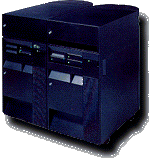DSM - Disk Space ManagerThe necessary tool to avoid a build up of unnecessary dataSave substantial amounts of disk space. DSM lets you do a full analysis of all objects in your system and reclaim wasted space. Any typical AS/400 installation contains tens of thousands of objects. These objects can be classified as |
|
||||
|
|
IBM system objects |
|
|||
|
|
Active user objects |
||||
|
|
Inactive user objects |
||||
|
Because of the large number of objects it is
very difficult to manage them manually. Inactive objects clutter the disk and
active objects may use more space than they need. DSM helps you to identify these problems
by printing exception reports that let you concentrate only on the objects
that need attention. It has tools to let you reclaim the wasted disk space. IBM system objects
IBM system objects, in principle should
not be touched. When shipped they are already at their minimum size. However
some system libraries such as QGPL, QRECOVERY and QRPLOBJ require periodic
inspection and cleanup. Active user objects
These objects can be reduced in size using one of three techniques |
|
||||
|
|
Source physical tiles can be compressed |
||||
|
|
Programs can have observability removed |
||||
|
|
Data physical files can be reorganized |
||||
|
Compressing source files shrinks its size
typically by more than 50%. DSM uses a very fast machine interface
(assembler) operation to perform compression and decompression. Removing
program observability reduces its size by up to 70%. Reorganizing data physical
files brings variable savings depending on the installation. Inactive user objects
These objects should be deleted (with or
without prior backup). DSM helps you to positively identify inactive objects. DSM looks at some big disk eaters. Save
files and journal receivers are two of them. Spooled files are another. When
you delete a spooled file, the operating system leaves an empty physical
member in library QSPL waiting to be reused. Some installations have hundreds
or even thousands of these inactive members doing nothing except occupying
valuable disk space. When DSM deletes a spooled file it removes
the whole thing including these empty members. DSM also analyzes the history log and
problem log. Duplicate objects analysis
Large space savings can be achieved by removing duplicate objects. Many times objects or even whole libraries are duplicated just for a quick test. But when the test ends the duplicate objects stay in the disk, unnoticed. DSM has special options to find out duplicate objects. If both objects have the same name, DSM will catch them. If they have different names but the same root name (example ITEM and ITEMOLD) DSM prints reports where they are shown close enough, to let an expert eye spot them. DSM functions
Disk space analysis
This function lets you print eighteen reports with several levels of summary/detail. |
|||||
|
|
Library name summary |
||||
|
|
Object type summary |
||||
|
|
Object attribute summary |
||||
|
|
Object name detail |
||||
|
In each report you may select the range of
libraries and object types/attributes to include or to exclude. A convenient
selection lets you also exclude objects and/or libraries below a minimum
size. Reports can be printed either in the
conventional alphabetic sequence or in descending object size sequence. For example a very popular option is a
short report that lists libraries in descending library size sequence. Reclaim space analysis
This function prints nine reports that let
you perform a "what if' analysis on your objects. Example - How much
space do I save if I delete all superseded save files? Or, if I delete all
spooled files that are more than 30 days old? Reclaim disk space
This option includes ten commands you can
use to clean up your disk. In principle these commands only perform
either harmless or recoverable operations. Example - A command lets you
remove observability of programs. But later on you can recompile the programs
to make them observable again. Another command lets you delete duplicate
objects. But DSM first checks that an original object exists. Auxilliary functions
This option lets you operate on compressed
source files (edit members,. compile members etc.), print/display the system
documentation and do general maintenance of the DSM system.
For
more information or a free fully functional
demo with manual:
download DSM (7.3 Mb)
or
contact us via the traditional communication channels:
InterData Systems, Inc. |
|||||
|
|
|
||||
